Implementing a Software-Defined Datacenter v1.0
Question 1
You install Microsoft System Center Operations Manager (SCOM) and download a sealed management pack.
You receive notifications from a monitor that a critical resource experiences an overload situation. When you check the resource, it is not in an overloaded condition.
You need to add a new threshold value for the resource.
What should you create?
- A. an override in an existing management pack
- B. an override in a new management pack
- C. a monitor in a new management pack
- D. a monitor in an existing management pack
Answer : B
Explanation:
Overrides change the configuration of System Center 2016 - Operations Manager monitoring settings for monitors, attributes, object discoveries, and rules.
As a best practice, save all overrides for each sealed management pack to an unsealed management pack that is named ManagementPack_Override, where
ManagementPack is the name of the sealed management pack to which the overrides apply.
References:
https://docs.microsoft.com/en-us/system-center/scom/manage-mp-override-rule-monitor?view=sc-om-1807 https://docs.microsoft.com/en-us/system-center/scom/manage-mp-create-unsealed-mp?view=sc-om-1807
Question 2
You deploy Microsoft System Center Virtual Machine Manager (SCVMM) and System Center Operations Manager (SCOM). You install the SCOM agent on the
SCVMM server. You install the SCVMM management pack.
You need to ensure that Performance and Resource Optimization (PRO) is available.
What should you run?
- A. the SCOM setup wizard
- B. the integration wizard in the SCVMM console
- C. the integration wizard in the SCOM console
- D. the SCVMM setup wizard
Answer : B
Explanation:
Run the integration wizard to integrate VMM and Operations Manager. The wizard does the following:
Imports the VMM management packs into Operations Manager.

-> Optionally enables Performance and Resource Optimization (PRO). PRO information is provided by Operations Manager, and can be VMM to optimize performance. You can map specific Operations Manager alerts to remedial actions in VMM. For example, you could migrate VMs to a different host after a hardware issue. In addition, with PRO enabled, Operations Managers can detect resource issues or hardware failures in the virtualization infrastructure.
-> Optionally enables maintenance mode. VMM can place hosts in maintenance mode for servicing. When a host is in maintenance mode, VMM uses live migration to move VMs to another location, and doesn't place new VMs on the host. If maintenance mode is enabled for Operations Manager monitoring, when a host is placed into maintenance mode in VMM, Operations Manager also places it in the same mode. In maintenance mode, the Operations Manager agent suppresses alerts, notifications, and state changes, so that the host isn't monitored while regular hardware and software maintenance activities are in progress.
-> Enables support for SQL Server Analysis Services (SSAS) and the reporting capabilities provided by SSAS.
References:
https://docs.microsoft.com/en-us/system-center/vmm/monitors-ops-manager?view=sc-vmm-1801
Question 3
DRAG DROP -
You use Microsoft System Center Operations Manager to monitor System Center Virtual Machine Manager (SCVMM). You establish baselines for the virtualization hosts.
You configure monitors to detect when a system is experiencing problems. You define an alert to report that the threshold value is exceeded.
You need to ensure that Operations Manager sends an email to the SDDCAdmins distribution group when the alert condition occurs.
Which three steps should you perform in sequence? To answer, move the appropriate actions from the list of actions to the answer area and arrange them in the correct order.
Select and Place:

Answer : 
Explanation:
Notification channels must be enabled before you create subscribers. After a subscriber is created, you create a notification subscription that defines the format of the notification message and any filters such as age or severity of the alert.
References:
https://docs.microsoft.com/en-us/system-center/scom/manage-notifications-create-subscribers?view=sc-om-1807
Question 4
You deploy Microsoft System Center Virtual Machine Manager (SCVMM). You configure shielded virtual machines (VMs) by using virtual Trusted Platform
Modules (vTPM). The shielded VMs are in the existing guarded fabric.
You deploy System Center Data Protection Manager (DPM).
You need to identify the scenarios for which you can use DPM to back up the VMs.
For which two scenarios can you use DPM? Each correct answer presents a complete solution.
- A. shielded VMs not protected with vTPM
- B. Item Level Recovery and Alternate Location Recovery outside of the guarded fabric
- C. Item Level Recovery and Alternate Location Recovery in the guarded fabric
- D. shielded VMs protected with vTPM
Answer : CD
Explanation:
DPM 2016 supports backup and recovery of Shielded VMs that have their VHDs/VHDXs protected with vTPM. Note that Item Level Recovery (ILR) and Alternate
Location Recovery (ALR) to a location outside the guarded fabric is not available for this scenario.
References:
https://docs.microsoft.com/en-us/system-center/dpm/what-s-new-in-dpm-2016?view=sc-dpm-1801
Question 5
DRAG DROP -
You plan to implement Microsoft System Center Virtual Machine Manager (SCVMM). The VMM environment will use shared ISO images with Hyper-V virtual machines. The SQL Server instance used by SCVMM must be able to communicate with other servers on the network.
You must install SCVMM on a server named VMM01 while minimizing the number of Active Directory Domain Services (AD DS) accounts that are created.
You need to install SCVMM.
Which three actions should you perform in sequence? To answer, move the appropriate actions from the list of actions to the answer area and arrange them in the correct order.
Select and Place:
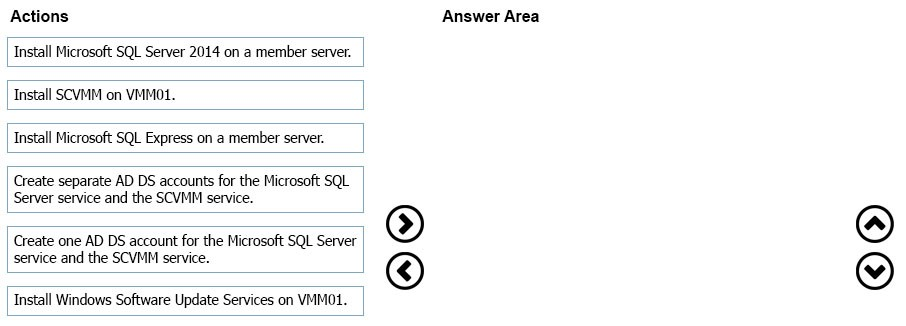
Answer : 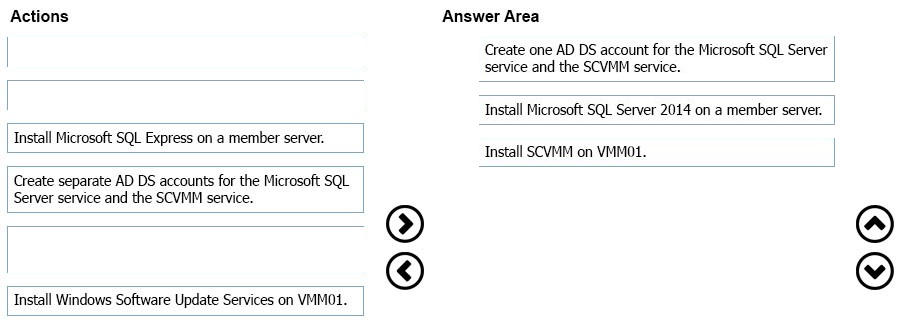
Explanation:
Question 6
You plan to deploy a Nano Server that has the Microsoft Hyper-V role installed.
You must deploy the Nano Server host in a hyper-converged mode that has a Microsoft System Center Virtual Machine Manager (SCVMM) agent installed. You need to prepare a Nano Server VHD for a physical machine.
Which three packages should you include in the VHD? Each correct answer presents part of the solution.
NOTE: Each correct selection is worth one point.
- A. Microsoft-NanoServer-DCB-Package
- B. Microsoft-NanoServer-SCVMM-Package
- C. Microsoft-NanoServer-SCVMM-Compute-Package
- D. Microsoft-NanoServer-Storage-Package
- E. Microsoft-NanoServer-NPDS-Package
Answer : BCD
Explanation:
The VHD should include the VMM packages:
-> Add the VMM package, Microsoft-NanoServer-SCVMM-Package, to ensure that the VMM agent is part of the VHD.
-> Add the VMM compute package, Microsoft-NanoServer-SCVMM-Compute-Package, to ensure that the VHD has the Hyper-V role, and that you can manage the physical server using VMM. If you install this package, don't use the -Compute option for the Hyper-V role).
-> For the File Server role, use Microsoft-NanoServer-Storage-Package, along with Microsoft-NanoServer-SCVMM-Package.
-> For a hyperconverged deployment, use Microsoft-NanoServer-Storage-Package, along with Microsoft-NanoServer-SCVMM-Package and Microsoft-
NanoServer-SCVMM-Compute-Package.
References:
https://docs.microsoft.com/en-us/system-center/vmm/hyper-v-nano?view=sc-vmm-2016
Question 7
HOTSPOT -
Ð company has an Active Directory Domain Services (AD DS) domain named corp.contoso.com.
You must install Microsoft System Center Virtual Machine Manager (SCVMM) and implement distributed key management (DKM). You must follow the principle of least privilege. Keys must be stored in a container named VMMKeys.
You need to ensure that you can store the cryptographic keys in AD DS.
How should you configure the environment? To answer, select the appropriate options in the dialog box in the answer area.
NOTE: Each correct selection is worth one point.
Hot Area:
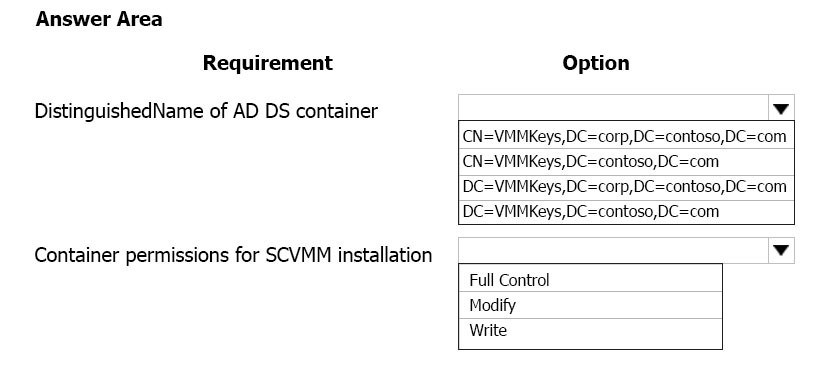
Answer : 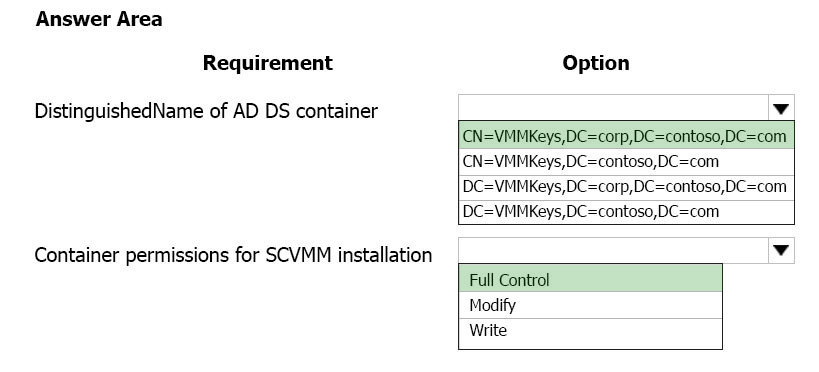
Explanation:
On the Configure service account and distributed key management page, you must specify the location of the container in AD DS by typing. For example, by typing CN=VMMDKM,DC=corp,DC=contoso,DC=com
The account with which you are installing VMM must have Full Control permissions to the container in AD DS.
References:
https://technet.microsoft.com/en-us/library/gg697604(v=sc.12).aspx
Question 8
You administer a Microsoft System Center Virtual Machine Manager (SCVMM) infrastructure. You have a Microsoft Azure subscription.
You must design a backup strategy that meets the following requirements:
-> Back up the SCVMM hosts, virtual machines (VMs), and workloads.
-> Use a protection agent to perform the backups.
Automate the backup process.

You need to recommend a backup solution.
What should you recommend?
- A. Windows PowerShell script that runs Disk2VHD
- B. Microsoft Hyper-V Replica
- C. WBAdmin.exe
- D. System Center Data Protection Manager
Answer : D
Explanation:
You can deploy System Center Data Protection Manager (DPM) for:
-> Application-aware backup: Application-aware back up of Microsoft workloads, including SQL Server, Exchange, and SharePoint.
-> File backup: Back up files, folders and volumes for computers running Windows server and Windows client operating systems.
-> System backup: Back up system state or run full, bare-metal backups of physical computers running Windows server or Windows client operating systems.
-> Hyper-V backup: Back up Hyper-V virtual machines (VM) running Windows or Linux. You can back up an entire VM, or run application-aware backups of
Microsoft workloads on Hyper-V VMs running Windows.
References:
https://docs.microsoft.com/en-us/system-center/dpm/dpm-overview?view=sc-dpm-1807
Question 9
DRAG DROP -
You manage Microsoft System Center Virtual Machine Manager (SCVMM).
You need to enable Data Deduplication for the SCVMM library server.
Which action should you perform for each configuration option? To answer, drag the appropriate action to the correct condition. Each action may be used once, more than once, or not at all. You may need to drag the split bar between panes or scroll to view content.
NOTE: Each correct selection is worth one point.
Select and Place:
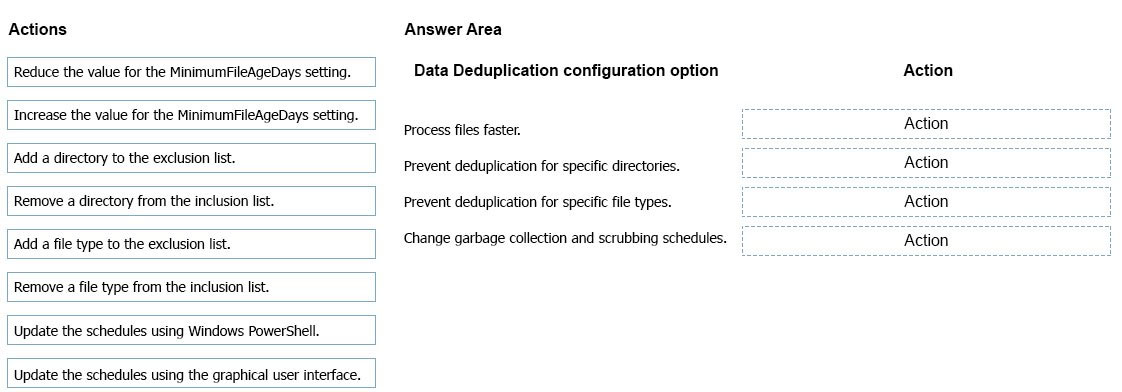
Answer : 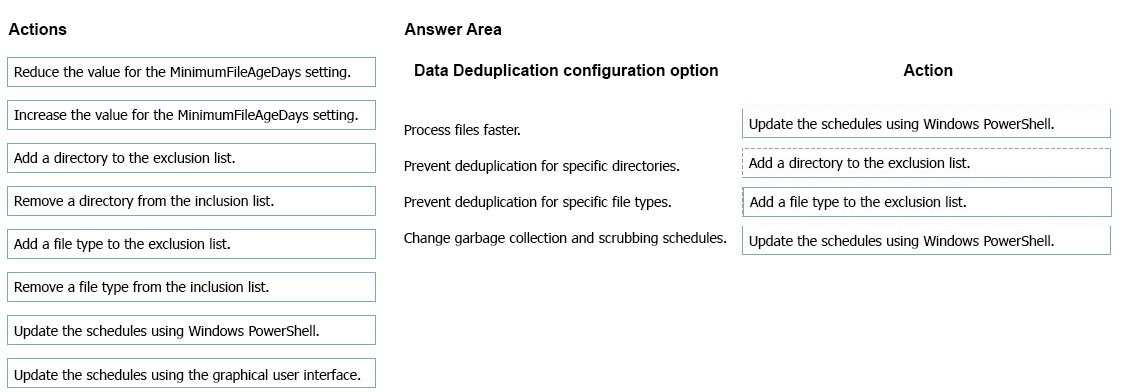
Explanation:
Data Deduplication jobs are scheduled via Windows Task Scheduler and can be viewed and edited there under the path Microsoft\Windows\Deduplication. Data
Deduplication includes several cmdlets that make scheduling easy. The most common reason for changing when Data Deduplication jobs run is to ensure that jobs run during off hours.
ExcludeFileType is for file types that are excluded from optimization.
ExcludeFolder specifies folder paths that should not be considered for optimization.
References:
https://docs.microsoft.com/en-us/windows-server/storage/data-deduplication/advanced-settings
Question 10
DRAG DROP -
You are securing the servers in Microsoft System Center Virtual Machine Manager (SCVMM).
You must use Network Controller to configure and manage servers that are on the same data plane as your Software Defined Network (SDN).
You need to configure the protocols and authentication types.
Which protocols and authentication types should you use for each server?
To answer, drag the appropriate protocols or authentication types to the correct devices or services. Each protocol or authentication type may be used once, more than once, or not at all. You may need to drag the split bar between panes or scroll to view content.
NOTE: Each correct selection is worth one point.
Select and Place:

Answer : 
Explanation:
The following table provides information about Network Controller interaction with different southbound devices.
Southbound device/service -
Protocol -
Authentication used -
Software Load Balancer -
WCF (MUX), TCP (Host)
Certificates -
Firewall -
OVSDB -
Certificates -
Gateway -
WinRM -
Kerberos, Certificates -
Virtual Networking -
OVSDB, WCF -
Certificates -
User defined routing -
OVSDB -
Certificates -
References:
https://docs.microsoft.com/en-us/windows-server/networking/sdn/security/nc-security
Question 11
You manage a datacenter that includes Software Defined Storage (SDS) and Microsoft System Center Virtual Machine Manager (SCVMM). You have a Microsoft
Azure subscription.
You need to automate the replication of Hyper-V virtual machines (VMs) to Azure by using Azure Site Recovery (ASR).
Which three resources should you implement? Each correct answer presents part of a solution.
NOTE: Each correct selection is worth one point.
- A. Bitlocker-enabled VMs
- B. Azure storage account
- C. Microsoft Hyper-V VMs with hot storage
- D. SCVMM host group
- E. Azure Recovery Services Vault
- F. Shielded VMs
Answer : BDE
Explanation:
Component -
Requirement -
Details -
Azure -
An Azure subscription, Azure storage account,
Replicated data from on-premises VM workloads is
and Azure network.
stored in the storage account. Azure VMs are
created with the replicated data when failover from
your on-premises site occurs.
The Azure VMs connect to the Azure virtual network
when they're created.
VMM server -
The VMM server has one or more clouds
You install the Site Recovery Provider on the VMM
containing Hyper-V hosts.
server, to orchestrate replication with Site Recovery,
and register the server in the Recovery Services
vault.
Hyper-V host -
One or more Hyper-V hosts/clusters managed
You install the Recovery Services agent on each
by VMM.
Hyper-V host or cluster node.
Hyper-V VMs -
One or VMs running on a Hyper-V host server. Nothing needs to explicitly installed on VMs.
Networking -
Logical and VM networks set up on the VMM
VM networks are mapped to Azure virtual networks.
server. The VM network should be linked to a
When Azure VMs are created after failover, they are
logical network that's associated with the
added to the Azure network that's mapped to the
cloud.
VM network.
References:
https://docs.microsoft.com/en-us/azure/site-recovery/hyper-v-azure-architecture
Question 12
You manage Microsoft System Center Virtual Machine Manager (SCVMM).
You need to ensure that all virtual machines (VMs) are fault tolerant. You must set storage tier sizes.
Which three Windows PowerShell cmdlets should you run? Each correct answer presents part of the solution.
NOTE: Each correct selection is worth one point.
- A. Optimize-Volume
- B. Enable-ClusterS2D
- C. Set-ClusterParameter
- D. New-Cluster
- E. New-Volume
Answer : BDE
Explanation:
Storage Spaces Direct uses industry-standard servers with local-attached drives to create highly available, highly scalable software-defined storage at a fraction of the cost of traditional SAN or NAS arrays.
The New-Cluster cmdlet creates a cluster. After creating the cluster, use the Enable-ClusterStorageSpacesDirect PowerShell cmdlet, which will put the storage system into the Storage Spaces Direct mode and do the following automatically:
-> Create a pool: Creates a single large pool that has a name like "S2D on Cluster1".
-> Configures the Storage Spaces Direct caches: If there is more than one media (drive) type available for Storage Spaces Direct use, it enables the fastest as cache devices (read and write in most cases)
-> Tiers: Creates two tiers as default tiers. One is called "Capacity" and the other called "Performance". The cmdlet analyzes the devices and configures each tier with the mix of device types and resiliency.
The use of the New-Volume cmdlet recommended to create volumes for Storage Spaces Direct. It provides the fastest and most straightforward experience.
References:
https://docs.microsoft.com/en-us/windows-server/storage/storage-spaces/storage-spaces-direct-overview https://docs.microsoft.com/en-us/windows-server/storage/storage-spaces/create-volumes
Question 13
Note: This question is part of a series of questions that present the same scenario. Each question in the series contains a unique solution that might meet the stated goals. Some question sets might have more than one correct solution, while others might not have a correct solution.
After you answer a question in this section, you will NOT be able to return to it. As a result, these questions will not appear in the review screen.
You use Microsoft System Center Virtual Machine Manager (SCVMM) to manage your company's virtual infrastructure.
You need to install a host server that can run the full version of the .NET framework.
Solution: Install the host server using the Desktop Experience installation option.
Does the solution meet the goal?
- A. Yes
- B. No
Answer : A
Explanation:
Application -
Server Core -
Server with Desktop Experience -
Command prompt -
available
available
Windows PowerShell/ Microsoft .NET
available
available
Perfmon.exe -
not available
available
Windbg (GUI)
supported
supported
Resmon.exe -
not available
available
Regedit -
available
available
Fsutil.exe -
available
available
Disksnapshot.exe -
not available
available
Diskpart.exe -
available
available
Diskmgmt.msc -
not available
available
Devmgmt.msc -
not available
available
Server Manager -
not available
available
Mmc.exe -
not available
available
Eventvwr -
not available
available
Wevtutil (Event queries)
available
available
Services.msc -
not available
available
Control Panel -
not available
available
Windows Update (GUI)
not available
available
Windows Explorer -
not available
available
Taskbar -
not available
available
Taskbar notifications -
not available
available
Taskmgr -
available
available
Application -
Server Core -
Server with Desktop Experience -
Internet Explorer or Edge -
not available
available
Built-in help system -
not available
available
Windows 10 Shell -
not available
available
Windows Media Player -
not available
available
PowerShell -
available
available
PowerShell ISE -
not available
available
PowerShell IME -
available
available
Mstsc.exe -
not available
available
Remote Desktop Services -
available
available
Hyper-V Manager -
not available
available
References:
https://docs.microsoft.com/en-us/windows-server/administration/server-core/what-is-server-core
Question 14
Note: This question is part of a series of questions that present the same scenario. Each question in the series contains a unique solution that might meet the stated goals. Some question sets might have more than one correct solution, while others might not have a correct solution.
After you answer a question in this section, you will NOT be able to return to it. As a result, these questions will not appear in the review screen.
You use Microsoft System Center Virtual Machine Manager (SCVMM) to manage your company's virtual infrastructure.
You need to install a host server that can run the full version of the .NET framework.
Solution: Install the host server as Windows Server 2016 Server Core.
Does the solution meet the goal?
- A. Yes
- B. No
Answer : B
Explanation:
Application -
Server Core -
Server with Desktop Experience -
Command prompt -
available
available
Windows PowerShell/ Microsoft .NET
available
available
Perfmon.exe -
not available
available
Windbg (GUI)
supported
supported
Resmon.exe -
not available
available
Regedit -
available
available
Fsutil.exe -
available
available
Disksnapshot.exe -
not available
available
Diskpart.exe -
available
available
Diskmgmt.msc -
not available
available
Devmgmt.msc -
not available
available
Server Manager -
not available
available
Mmc.exe -
not available
available
Eventvwr -
not available
available
Wevtutil (Event queries)
available
available
Services.msc -
not available
available
Control Panel -
not available
available
Windows Update (GUI)
not available
available
Windows Explorer -
not available
available
Taskbar -
not available
available
Taskbar notifications -
not available
available
Taskmgr -
available
available
Internet Explorer or Edge -
not available
available
Built-in help system -
not available
available
Windows 10 Shell -
not available
available
Windows Media Player -
not available
available
PowerShell -
available
available
PowerShell ISE -
not available
available
PowerShell IME -
available
available
Mstsc.exe -
not available
available
Remote Desktop Services -
available
available
Hyper-V Manager -
not available
available
References:
https://docs.microsoft.com/en-us/windows-server/administration/server-core/what-is-server-core
Question 15
Note: This question is part of a series of questions that present the same scenario. Each question in the series contains a unique solution that might meet the stated goals. Some question sets might have more than one correct solution, while others might not have a correct solution.
After you answer a question in this section, you will NOT be able to return to it. As a result, these questions will not appear in the review screen.
You use Microsoft System Center Virtual Machine Manager (SCVMM) to manage your company's virtual infrastructure.
You need to install a host server that can run the full version of the .NET framework.
Solution: Install a host server that runs Windows Server 2016 R2 Server Core. Add the Desktop Experience feature.
Does the solution meet the goal?
- A. Yes
- B. No
Answer : A
Explanation:
Application -
Server Core -
Server with Desktop Experience -
Command prompt -
available
available
Windows PowerShell/ Microsoft .NET
available
available
Perfmon.exe -
not available
available
Windbg (GUI)
supported
supported
Resmon.exe -
not available
available
Regedit -
available
available
Fsutil.exe -
available
available
Disksnapshot.exe -
not available
available
Diskpart.exe -
available
available
Diskmgmt.msc -
not available
available
Devmgmt.msc -
not available
available
Server Manager -
not available
available
Mmc.exe -
not available
available
Eventvwr -
not available
available
Wevtutil (Event queries)
available
available
Services.msc -
not available
available
Control Panel -
not available
available
Windows Update (GUI)
not available
available
Application -
Server Core -
Server with Desktop Experience -
Windows Explorer -
not available
available
Taskbar -
not available
available
Taskbar notifications -
not available
available
Taskmgr -
available
available
Internet Explorer or Edge -
not available
available
Built-in help system -
not available
available
Windows 10 Shell -
not available
available
Windows Media Player -
not available
available
PowerShell -
available
available
PowerShell ISE -
not available
available
PowerShell IME -
available
available
Mstsc.exe -
not available
available
Remote Desktop Services -
available
available
Hyper-V Manager -
not available
available
References:
https://docs.microsoft.com/en-us/windows-server/administration/server-core/what-is-server-core